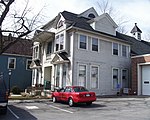New York Museum of Transportation
Heritage railroads in New York (state)Museums in Monroe County, New YorkRailroad museums in New York (state)Streetcars in New York (state)

The New York Museum of Transportation (NYMT), founded in 1975, is a non-profit organization located at 6393 East River Road, in the Rochester suburb of Rush. A private rail line built by volunteers connects NYMT with the Rochester & Genesee Valley Railroad Museum, over a distance of two miles. This demonstration railway allows both museums to offer train rides with their collections of vintage railroad equipment. NYMT operates the only electric trolley ride in New York State, not to be confused with the similarly named Trolley Museum of New York located in Kingston, New York.
Excerpt from the Wikipedia article New York Museum of Transportation (License: CC BY-SA 3.0, Authors, Images).New York Museum of Transportation
East River Road,
Geographical coordinates (GPS) Address External links Nearby Places Show on map
Geographical coordinates (GPS)
| Latitude | Longitude |
|---|---|
| N 43.016388888889 ° | E -77.71 ° |
Address
New York Museum of Transportation
East River Road 6393
14586
New York, United States
Open on Google Maps









